SUMMARY: A simple model of the CO2 concentration of the atmosphere is presented which fairly accurately reproduces the Mauna Loa observations 1959 through 2018. The model assumes the surface removes CO2 at a rate proportional to the excess of atmospheric CO2 above some equilibrium value. It is forced with estimates of yearly CO2 emissions since 1750, as well as El Nino and La Nina effects. The residual effects of major volcanic eruptions (not included in the model) are clearly seen. Two interesting finding are that (1) the natural equilibrium level of CO2 in the atmosphere inplied by the model is about 295 ppm, rather than 265 or 270 ppm as is often assumed, and (2) if CO2 emissions were stabilized and kept constant at 2018 levels, the atmospheric CO2 concentration would eventually stabilize at close to 500 ppm, even with continued emissions.
A recent e-mail discussion regarding sources of CO2 other than anthropogenic led me to revisit a simple model to explain the history of CO2 observations at Mauna Loa since 1959. My intent here isn’t to try to prove there is some natural source of CO2 causing the recent rise, as I think it is mostly anthropogenic. Instead, I’m trying to see how well a simple model can explain the rise in CO2, and what useful insight can be deduced from such a model.
The model uses the Boden et al. (2017) estimates of yearly anthropogenic CO2 production rates since 1750, updated through 2018. The model assumes that the rate at which CO2 is removed from the atmosphere is proportional to the atmospheric excess above some natural “equilibrium level” of CO2 concentration. A spreadsheet with the model is here.
Here’s the assumed yearly CO2 inputs into the model:
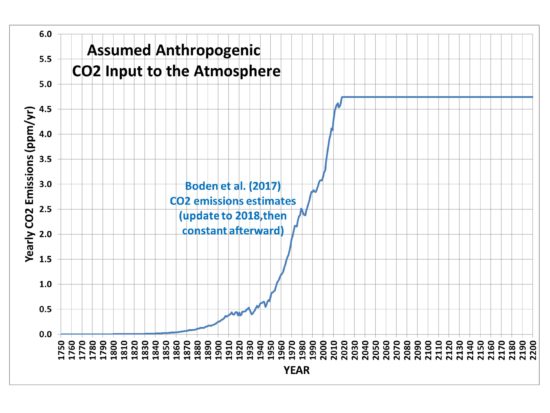
I also added in the effects of El Nino and La Nina, which I calculate cause a 0.47 ppm yearly change in CO2 per unit Multivariate ENSO Index (MEI) value (May to April average). This helps to capture some of the wiggles in the Mauna Loa CO2 observations.
The resulting fit to the Mauna Loa data required an assumed “natural equilibrium” CO2 concentration of 295 ppm, which is higher than the usually assumed 265 or 270 ppm pre-industrial value:
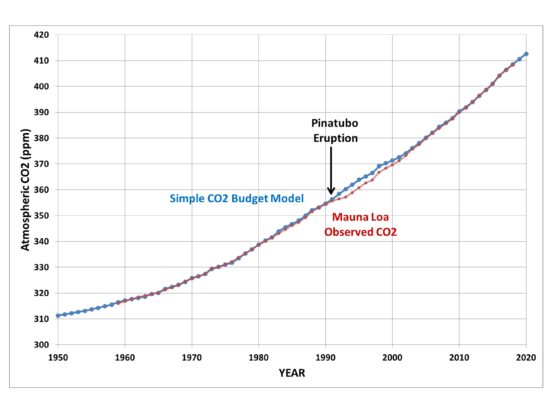
Click on the above plot and notice just how well even the little El Nino- and La Nina-induced changes are captured. I’ll address the role of volcanoes later.
The next figure shows the full model period since 1750, extended out to the year 2200:
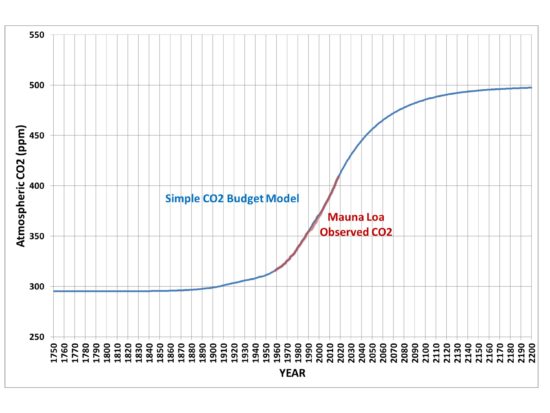
Interestingly, note that despite continued CO2 emissions, the atmospheric concentration stabilizes just short of 500 ppm. This is the direct result of the fact that the Mauna Loa observations support the assumption that the rate at which CO2 is removed from the atmosphere is directly proportional to the amount of “excess” CO2 in the atmosphere above a “natural equilibrium” level. As the CO2 content increases, the rate or removal increases until it matches the rate of anthropogenic input.
We can also examine the removal rate of CO2 as a fraction of the anthropogenic source. We have long known that only about half of what is emitted “shows up” in the atmosphere (which isn’t what’s really going on), and decades ago the IPCC assumed that the biosphere and ocean couldn’t keep removing excess CO2 at such a high rate. But, in fact, the fractional rate of removal has actually been increasing, not decreasing.And the simple model captures this:
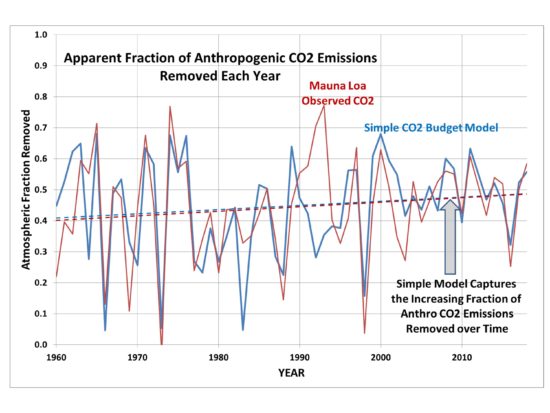
The up-and-down variations in Fig. 4 are due to El Nino and La Nina events (and volcanoes, discussed next).
Finally, a plot of the difference between the model and Mauna Loa observations reveals the effects of volcanoes. After a major eruption, the amount of CO2 in the atmosphere is depressed, either because of a decrease in natural surface emissions or an increase in surface uptake of atmospheric CO2:
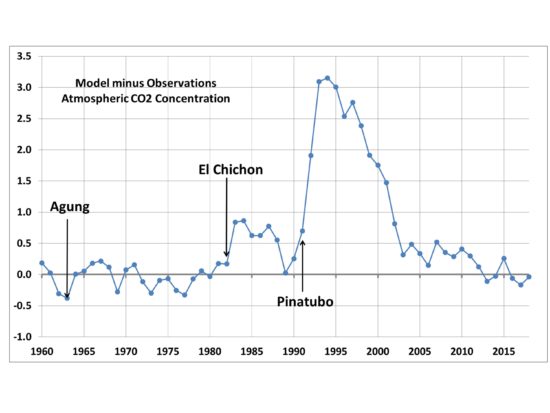
What is amazing to me is that a model with such simple but physically reasonable assumptions can so accurately reproduce the Mauna Loa record of CO2 concentrations. I’ll admit I am no expert in the global carbon cycle, but the Mauna Loa data seem to support the assumption that for global, yearly averages, the surface removes a net amount of CO2 from the atmosphere that is directly proportional to how high the CO2 concentration goes above 295 ppm. The biological and physical oceanographic reasons for this might be complex, but the net result seems to follow a simple relationship.

 Home/Blog
Home/Blog




The pause in acceleration from 2013 to 2016 may not be representative of the future trend. | damaged foundation
Here is Dr Spencer’s model with MIE removed. It looks like the discrepancy is simply SST related.
https://climategrog.files.wordpress.com/2022/07/spencer-model-withoutmie.png
Note ” the ice age cometh” and the “OMG the panel is on fire” climate periods quite clearly reflected in the graph.
Somebody needs to account for Henry’s law and Fick’s law. “Basic physics” as they always like to say.
Mt Pinatubo eruption is the greatest natural experiment we have.
Any model needs to account for this period in a serious and accurate way, not just leave a significant mismatch.
You can always match a monotonic rise, what determines the skill of any model is its ability to get the ups and downs in the right place too.
This is the major failure of ALL climate models which total fail to capture the early 20th c. rise in temperature because they are CO2 based and CO2 does NOT match what the climate record shows.
i think we are destroying ourselves. take care of the world!